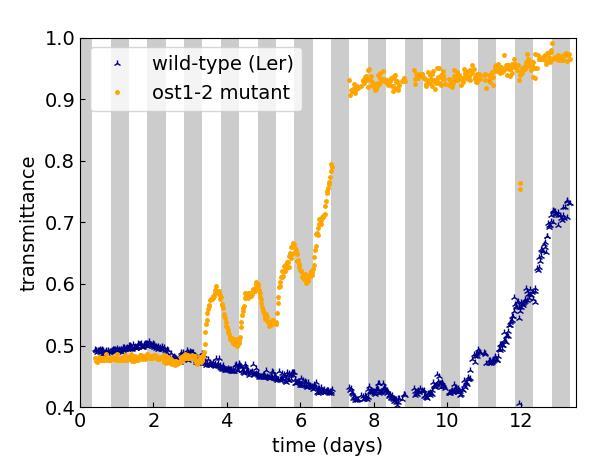
4 minute read
J.Taiber Investigation of the influence of the stomatal activity on the water content of plant leaves under drought stress using THz spectroscopy
Investigation of the influence of the stomatal activity on the water content of plant leaves under drought stress using THz spectroscopy
Jochen Taiber1 , Johannes Herrmann2 , Peter Ache2 , Enrique Castro-Camus3 , Rainer Hedrich2 and Martin Koch1 1Philipps-Universität Marburg, Institut für Physik, 35032 Marburg, Germany 2Universität Würzburg, Julius-von-Sachs-Institut für Biowissenschaften, 97082 Würzburg, Germany 3Centro de Investigaciones en Optica A.C., 37150 Leon, GTO, Mexico
Advertisement
Abstract—We used Terahertz (THz) time-domain spectroscopy in order to compare the water dynamics of wild-type and ost1-2 mutant of Arabidopsis thaliana. We found significant differences in the dehydration dynamics: the mutant dehydrates much earlier due to the lack of stomatal control as a consequence of the mutated OST1 kinase and shows strong oscillations in water content related to the 24 hours illumination cycle.
I. INTRODUCTION
The loss of water of plants through transpiration is mainly regulated by the stomata which also control the uptake of CO2 for photosynthesis. If water stress occurs, the plant synthesizes ABA (abscisic acid). In response to this hormone, the protein kinase OST1 (open stomata 1) in wild-type Arabidopsis activates the guard-cell anion release channel SLAC1 (slow anion channel-associated 1) which triggers stomatal closure to limit dehydration [1, 2]. For this reason, the guard cells of plants with mutated OST1 do not respond to ABA and therefore cannot close their stomata during the day to reduce water loss; the mutation does not affect the stomata regulation by light [3]. In this contribution we will present THz in vivo measurements of wild-type and OST1 mutated Arabidopsis which show that the mutated variety undergoes severe dehydration earlier than the wild-type one and shows larger day-night water content oscillations.
II. RESULTS
We used Terahertz (THz) time-domain spectroscopy in order to compare the water dynamics of Arabidopsis thaliana Landsberg erecta (wild-type) and ost1-2 mutant. The measurements were performed using a fiber-coupled sensor head mounted on a carousel system. Thus, 7 individual living plants from each genome could be measured every 25 minutes.
Fig. 1 shows the measured transmittance of the plant leaf, the curves shown are representative of 7 independent plants of each genome: since water is highly absorbing in the THz band, the higher the transmittance, the lower the water content.
Within the first few days, each plant can maintain its optimal water status and the day-night cycle is only slightly visible. But after 3 days, the ost1-2 mutant begins to lose substantial amounts of water under illuminated conditions. Due to the mutated OST1 kinase, the drought induced ABA generation does not result anymore in the closure of the stomata because the signal path is blocked. During night periods, the plant is able to close its stomata and accumulate water which explains the decrease in transmittance and thus the strong oscillations in the water content of the leaf. The wild-type Arabidopsis can maintain the optimal water status until approximately day 10 by closing its stomata during the illumination period. From this point on, the leaf also dries out during the day, but to a lesser extent compared to the ost1-2 mutant, whereas the recovery phase is suppressed due to the lack of water in the pot.
Fig. 1. Transmittance of two plant leaves of wild-type and ost1-2 Arabidopsis as a function of time. High transmittance corresponds to low water content. Illuminated periods are indicated white, dark periods grey.
III. SUMMARY
In contrast to alternative methods (e.g. the use of pressure sensors), THz spectroscopy allows direct measurement of the water content of a leaf and therefore offers an excellent possibility to investigate genetic influences on the regulation of water content. Our experiments show that the ability to resist dehydration and maintaining the optimal water status of the leaves strongly depends on the ability of stomatal control. Mutants with insensitivity to ABA (due to mutated OST1) are incapable to close their stomata under illuminated conditions. Further investigations considering soil moisture will deepen the knowledge of the stomata role during dehydration.
REFERENCES
[1]M.R.G. R e e a, R. Hed c , I e ight of stomatal opening: new e Wa e a e , Ne P tologist, 167, pp. 665-691, Sep, 2005. [2]P. Ac e e a ., S a a ac d ec eed bac ea : e insights into the regulation of the plant water status from non-invasive e e be ea e e , T e P a Journal, 62, pp. 1072-1082, June, 2010. [3]A. M e a ., A ab d OST1 P e K a e Med a e e Regulation of Stomatal Aperture by Abscisic Acid and Acts Upstream of Reactive Oxygen Species Productio , T e P a Ce , 14, . 3089-3099, Dec, 2002.
We acknowledge financial support from the A. v. Humboldt Foundation.









